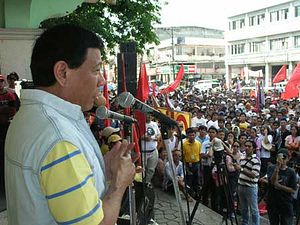Of late, a new wave of speculation has arisen surrounding Philippine President Rodrigo Duterte. Accusations have emerged that the Communist Party of the Philippines (CPP) is conspiring with other political forces, attempting to build a critical mass that will push for Duterte’s ouster from power.
The initial wave began when the Philippine military disclosed that a so-called “Red October” plot is being readied by the CPP in connivance with some members of Liberal Party and Magdalo to force Duterte to declare Martial Law and use this emergency situation to provoke mass uprisings across the country. The Liberal Party was the party that governed the Philippines before Duterte, while Magdalo is composed mostly of former junior officers of the military who tried to launch a coup against the government of former President Gloria Arroyo.
Authorities added that the Red October plot is a “rolling plan,” which means its timetable is not fixed and thus it can be implemented anytime before Duterte finishes his single six-year term, which began in 2016. The military has presented various reports highlighting how the CPP is undertaking the ouster plot. But in recent days, the reliability of these reports has been questioned, even by some agencies of the government itself.
A joint security operation that supposedly targeted CPP operatives behind the plot was later revealed to be an anti-crime raid not connected with Red October. Top officers of the military also subsequently cleared Magdalo and the Liberal Party, but the president’s spokesperson insisted that there is an alliance between the CPP and leading members of the opposition.
The military also tagged several Metro Manila schools where the CPP is supposedly recruiting members to join its army. But school officials have already come forward to deny that there are student activities supporting the Red October plot. The military list also included a school which does not exist.
What the military didn’t mention is that, beyond this Red October plot to overthrow Duterte, most of the students have also been involved in legal, workaday protests against the controversial policies of the Duterte government — protests that are common in a vibrant democracy like the Philippines. This led some to suspect that news of the Red October plot could be intended to stem growing outrage against rising prices and continuing human rights abuses perpetrated by state forces.
The plot was also revealed while many student groups were set to participate in a protest marking the 46th anniversary of the Martial Law declaration. Student activists were among those who expressed concern about the return of strongman rule in the country.
The CPP dismissed the plot and accused the Duterte government of creating a scenario to justify a massive crackdown on dissenters. The CPP acknowledged that many groups are now coalescing to resist tyranny, but it denied that there’s a conspiracy between leftists and some rightists.
The CPP could be referring to the unity protest organized in July during Duterte’s third state of the nation address. Members of Magdalo and the Liberal Party were among those who joined forces with other groups in marching against the return of authoritarianism. But the protest didn’t outright demand the ouster of Duterte, because some groups in the coalition felt that they are not yet ready to support this.
Perhaps the Red October plot exposed by the military was a belated reaction to this unity protest. Fearful of the growing ranks of the opposition, the government is now aiming to discredit the efforts of erstwhile rival political forces that are now overcoming their differences in order to mount a formidable challenge to Duterte’s anti-democratic programs.
This is not the first time that Duterte tried to raise public alarm over a plot directed against his government. He once accused foreign powers of drafting a blueprint designed to destabilize his government. Now he appears to be lumping all street protests and initiatives aimed at countering his repressive policies together as part of a sinister ouster plot.
Duterte claims that majority of Filipinos continue to trust his government. Why, then, do he and his government need this repeated assertion of real or imagined conspiracies if they’re confident of public support? One fears that Duterte has either become a victim of his own paranoia, or, worse, he is setting the political conditions that would allow him to brutally suppress all forces opposing his government.

































